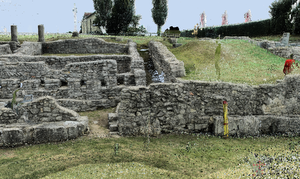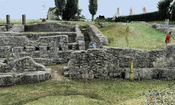Information
- Publication Type: Conference Paper
- Workgroup(s)/Project(s):
- Date: November 2011
- ISBN: 978-3-200-02740-4
- Location: Vienna, Austria
- Lecturer: Claus Scheiblauer
- Booktitle: Proceedings of the 16th International Conference on Cultural Heritage and New Technologies
- Conference date: 14. November 2011 – 16. November 2011
- Pages: 242 – 247
- Keywords: point rendering, resampling, out-of-core
Abstract
Terrestrial laser scanners are used at many excavations for documentation and inventory taking. For the documentation of the excavation Amphitheatre 1 in Bad Deutsch-Altenburg, Austria, the terrestrial laser scanner Riegl LMS Z420i was used. Overall, the entire excavation was covered by about 200 positions. With each scan position the amount of data recorded increases and this leads to performance problems in the visualization of the data. Due to the enormous number of points a consolidated representation of the entire point cloud is not possible with conventional software. The software Scanopy was developed for presenting and editing huge amounts of point data. Furthermore, it is possible to load polygonal models and display them together with point clouds in one scene. This allows an exact documentation of large archaeological excavation sites. Another application is the visualization of polygonal models of different excavation levels. The simplest visualization of point clouds on screen is a representation of the points as square rectangles. This, however, creates geometric inaccuracies, and colored point clouds are presented with sudden color changes. When the points are displayed by using semi-transparent circles the 3D points can be blended and lead to a more homogenous visual representation of the scanned objects. Thus the visual impression of the point cloud will be improved considerably. The developed software is demonstrated on the excavation mentioned above.Additional Files and Images
Weblinks
No further information available.BibTeX
@inproceedings{scheiblauer-2011-chnt,
title = "Consolidated Visualization of Enormous 3D Scan Point Clouds
with Scanopy",
author = "Claus Scheiblauer and Michael Pregesbauer",
year = "2011",
abstract = "Terrestrial laser scanners are used at many excavations for
documentation and inventory taking. For the documentation of
the excavation Amphitheatre 1 in Bad Deutsch-Altenburg,
Austria, the terrestrial laser scanner Riegl LMS Z420i was
used. Overall, the entire excavation was covered by about
200 positions. With each scan position the amount of data
recorded increases and this leads to performance problems in
the visualization of the data. Due to the enormous number of
points a consolidated representation of the entire point
cloud is not possible with conventional software. The
software Scanopy was developed for presenting and editing
huge amounts of point data. Furthermore, it is possible to
load polygonal models and display them together with point
clouds in one scene. This allows an exact documentation of
large archaeological excavation sites. Another application
is the visualization of polygonal models of different
excavation levels. The simplest visualization of point
clouds on screen is a representation of the points as square
rectangles. This, however, creates geometric inaccuracies,
and colored point clouds are presented with sudden color
changes. When the points are displayed by using
semi-transparent circles the 3D points can be blended and
lead to a more homogenous visual representation of the
scanned objects. Thus the visual impression of the point
cloud will be improved considerably. The developed software
is demonstrated on the excavation mentioned above.",
month = nov,
isbn = "978-3-200-02740-4",
location = "Vienna, Austria",
booktitle = "Proceedings of the 16th International Conference on Cultural
Heritage and New Technologies",
pages = "242--247",
keywords = "point rendering, resampling, out-of-core",
URL = "https://www.cg.tuwien.ac.at/research/publications/2011/scheiblauer-2011-chnt/",
}

 paper
paper
